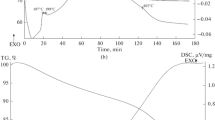Abstract
A precursor gel was prepared by desiccation of an aqueous solution of zirconium acetate and pyrolyzed to form crystalline powders in selected gas environments. Thermal analysis, X-ray powder diffraction, mass spectrometry and Fourier transform infrared spectroscopy were used to investigate the decomposition of the gel and the transformations occurring during pyrolysis to 800°C in nitrogen, air and oxygen. Three transition temperatures were detected: the amorphous-to-cubic crystal transformation, cubic-to-tetragonal transformation, and the initiation of tetragonal-to-monoclinic transition. The presence of molecular oxygen decreased the crystallization temperature, increased the grain size of the tetragonal crystals formed and decreased the temperature at which the tetragonal-to-monoclinic transformation was initiated. The decrease in the crystallization temperature in the presence of oxygen occurred despite an increase in the temperature corresponding to the loss of the major portion of the organic component of the gel.
Similar content being viewed by others
References
B.E. Yoldas, J. Mater. Sci. 21, 1080 (1986).
R. Srinivasan, C.R. Hubbard, O.B. Cavin, and B.H. Davis, Chem. Mater. 5, 27 (1993).
A. Samdi, Th. G. Baron, B. Durand, and M. Roubin, Ann.Chim. Fr. 13, 483 (1988).
E. Leroy, C.R. Brosse, and J.P. Torre,in Ultrastructure Processing of Ceramics, Glasses and Composites, edited by L.L. Hench and D.R. Ulrich (Wiley, NY, 1984), p. 219.
K.K. Li,A Study of PLZT Ferroelectric Thin Films Chemically Derived from Acetate Precursors, Ph.D. Dissertation, Clemson University, August 1993.
E.C. Subbarao, inAdvances in Ceramics, Vol. 3, Science and Technology of Zirconia, edited by A.H. Heuer and L.W. Hobbs (The American Ceramic Society, 1981), Vol. 3, p. 1.
M. Yashima, T. Kato, M. Kakihana, M.A. Gulgun, Y. Matsuo, and M. Yoshimura, J. Mater. Res. 12, 2575 (1997).
Computer AidedResearch&Development(CARDVersion 5.0), S-Matrix Corporation, 1997.
H.P. Klug and L.E. Alexander, X-Ray Diffraction Procedures (Wiley, NY,1974).
D.A. Ward and E.I. Ko, Chem. Mater. 5, 956 (1993).
W.B. Blumenthal, The Chemical Behavior of Zirconium (D. Van Nostrand Co., Inc., 1958), p. 315.
R.C. Garvie, J. Phys. Chem. 82, 218(1985).
M.L. Balmer, F.F. Lange, and C.G. Levi, J. Am. Ceram. Soc.75, 946 (1992).
R. Srinivasan, T.R. Watkins, C.R. Hubbard, and B.H. Davis, J. Mater. 7, 725 (1995).
R. Srinivasan, R. De Angelis,and B.H. Davis, J. Mater. Sci. 1, 583 (1986).
Author information
Authors and Affiliations
Rights and permissions
About this article
Cite this article
Geiculescu, A.C., Spencer, H.G. Effect of Oxygen Environment on the Decomposition and Crystallization of an Aqueous Sol-Gel Derived Zirconium Acetate Gel. Journal of Sol-Gel Science and Technology 14, 257–272 (1999). https://doi.org/10.1023/A:1008717512581
Issue Date:
DOI: https://doi.org/10.1023/A:1008717512581




